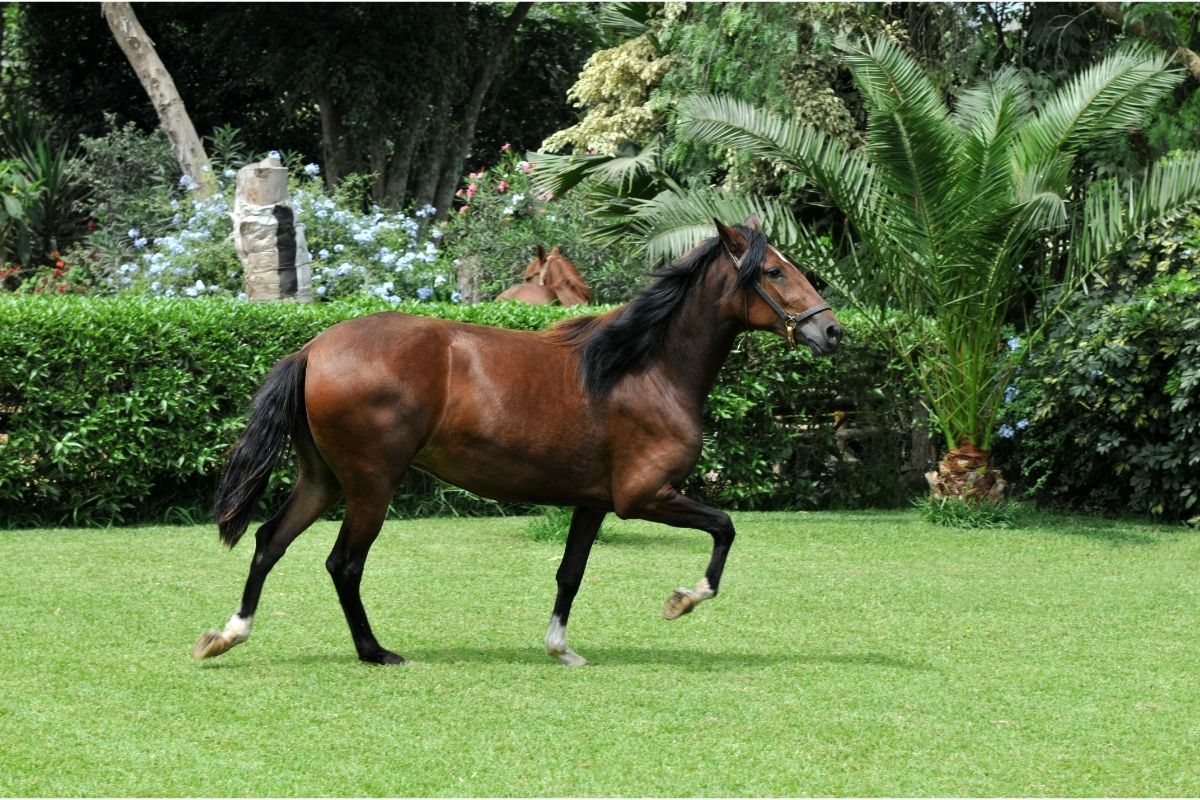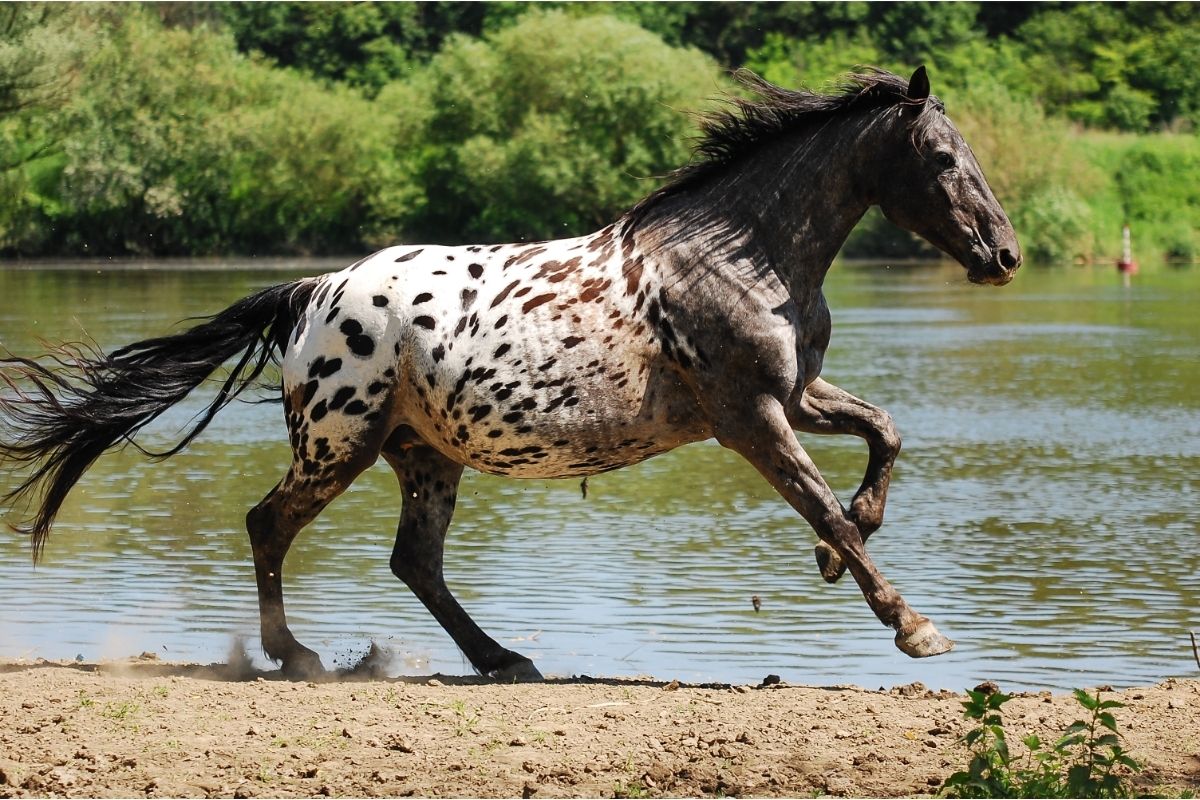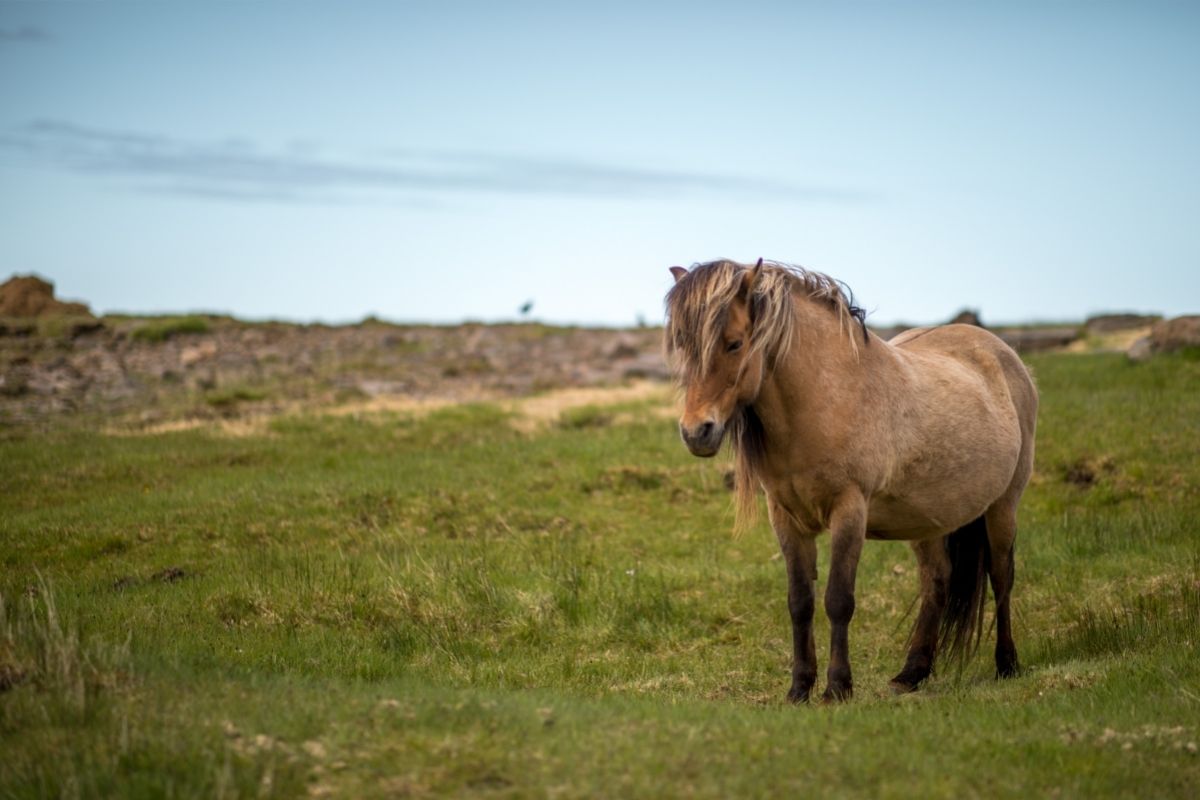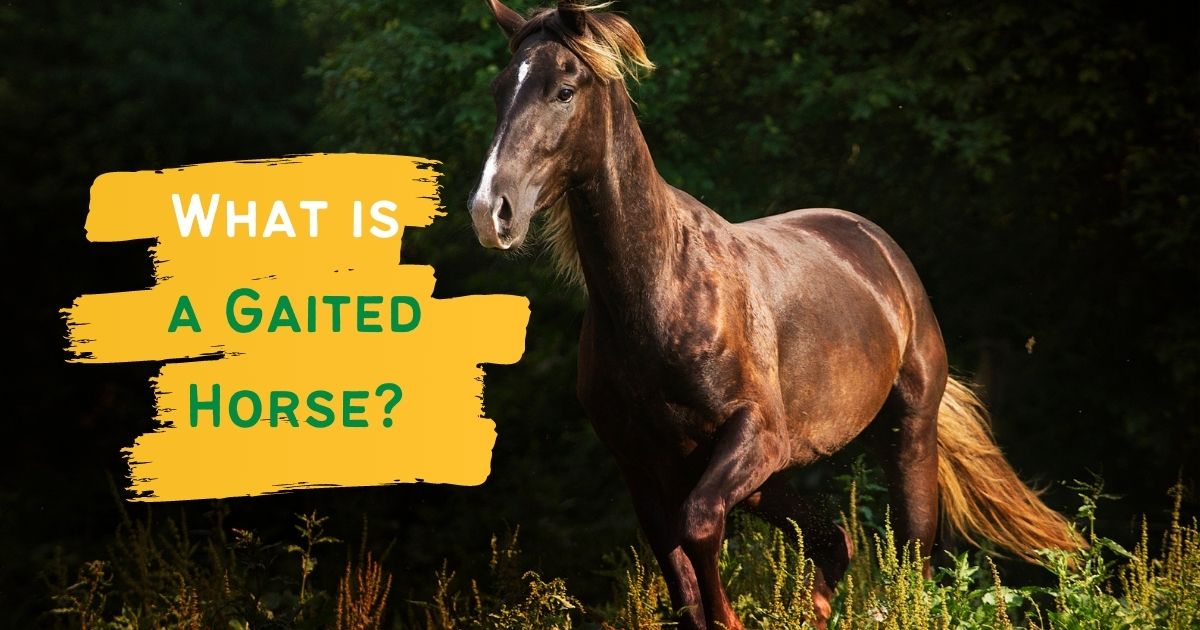Have you ever tested how many equine phrases and terms you know? For example, do you know what is a gaited horse? If you want to become an experienced equestrian, you have to keep on topping up your knowledge reserves, among other things.
One of the terms you need to know and understand is a gaited horse. What does it mean when a horse is gaited? Let us explore all you need to know.

What is a Gaited Horse?
A gaited horse (walking horse) keeps one of its legs on the ground at all times when walking. Its legs move independently. For this reason, it can reserve more energy than a horse that trots. Also, it has endurance and stamina for covering long distances. You will never find this type of horse suspended in the air during any activity.
A List of Gaited Horse Breeds (Naturally)
Sometimes, a horse’s gaiting behavior is natural. It is an inherent trait that some horses adopt at a tender age. However, other horses require training to adopt the behavior. Some of the natural types of gaited horses are:
Tennessee Walking Horse
- Height: 56 inches (142.24 centimeters) (14 hands) to 68 inches (172.72 centimeters) (17 hands)
- Weight: 900 to 1,200 pounds (405 to 540 kilograms)
- Physical appearance: Muscular, straight profile, small ears, and long head
The Tennessee gaited horse is popular in North America for its smooth gait and calmness. In the early days, people used it for farm work. It walks in a four-beat and flashy gait.
Marwari Horse
- Height: 56 inches (142.24 centimeters) (14 hands) to 64 inches (162.56 centimeters) (16 hands)
- Weight: 750 to 1,000 pounds (337.5 to 450 kilograms)
- Physical appearance: Sickle-shapes ears, small hooves, slender legs, and long back
This Indian walking horse uses an ambling gait. It also goes by the names Revaal, Aphcal, or Rehwal. Marwari is a natural performer that befits exhibitions, polo, and dressage competitions.
Peruvian Paso
- Height: 56 inches (142.24 centimeters) (14 hands) to 60 inches (152.4 centimeters) (15 hands)
- Weight: 900 to 1,100 pounds (405 to 495 kilograms)
- Physical appearance: Muscular build, low tail, and deep chest
Paso is a Peruvian national horse. It is popular for its smooth ride and elegant carriage. Also, its two popular gaits are the slow Paso Llano and the fast Sobreandando.
Paso Fino
- Height: 52 inches (132.08 centimeters) (13 hands) to 60 inches (152.4 centimeters) (15 hands)
- Weight: 700 to 1,100 pounds (315 to 495 kilograms)
- Physical appearance: Small head, projecting withers, and relatively short back
Paso Fino is a Spanish phrase. It means a delicate passage. Paso Fino horse comes from the Caribbean islands, including Cuba, Colombia, and Puerto Rico. It carries riders over the rugged terrain of the islands and coastal homes.
Kentucky Mountain Saddle Horse
- Height: 44 inches (111.76 centimeters) (11 hands) to 64 inches (162.56 centimeters) (16 hands)
- Weight: 950 to 1,200 pounds (202.5 to 540 kilograms)
- Physical appearance: Muscular build, deep chest, and flat-facial profile
This sure-footed, even-tempered gaited horse uses a natural four-beat (amble or rack) gait on its course. It can move at canter speed while keeping its rider sitting motionlessly.
Icelandic Horse
- Height: 56 inches (142.24 centimeters) (14 hands) to 68 inches (172.72 centimeters) (17 hands)
- Weight: 900 to 1,200 pounds (405 to 540 kilograms)
- Physical appearance: Deep chest, squat-legged, shaggy fur, and long back
Icelandic horses are tolerant of harsh conditions. These sure-footed horses move at a single-footed pace that Icelanders call Tolt. Their riders use them for leisure riding, horse shows, and harness races.
Appaloosa
- Height: 56 inches (142.24 centimeters) (14 hands) to 60 inches (152.4 centimeters) (15 hands)
- Weight: 950 to 1,200 pounds (202.5 to 540 kilograms)
- Physical appearance: Colorful coat, striped hooves, and mottled skin
An Appaloosa uses a lateral four-beat gait where its same-sided legs move together. Its other name is Appaloosa shuffle. The Tennessee Walker and an Appaloosa run in a similar style.
American Standardbred
- Height: 60 inches (152.4 centimeters) (14 hands) to 64 inches (162.56 centimeters) (16 hands)
- Weight: 900 to 1,000 pounds (405 to 450 kilograms)
- Physical appearance: Muscular legs, deep chest, and thick tail and mane
An American standardbred is a popular harness racehorse. It can ride, Pace at a single-foot amble, and trot at a single-foot or running walk. However, its pacers kind of race faster than its trotters.
American Saddlebred
- Height: 60 inches (152.4 centimeters) (14 hands) to 68 inches (172.72 centimeters) (17 hands)
- Weight: 1000 to 1,200 pounds (450 to 540 kilograms)
- Physical appearance: Muscular build, arched neck, high tail carriage, and short back
The American Standardbred is a popular horse in parades. It is flashy. Also, it uses five different gaits, including a rack and a slow gait. A rack is a lateral gait with four-beat equal movements.
Morgan
- Height: 56 inches (142.24 centimeters) (14 hands) to 60 inches (152.4 centimeters) (15 hands)
- Weight: 900 to 1,100 pounds (405 to 495 kilograms)
- Physical appearance: Shorthead, wide forehead, thick tail and mane, and muscular neck
The Morgan breed has both naturally gaited and non-gaited horses. Its genetics combine Thoroughbred, Standardbred, Saddlebred horses. According to scientists, a fifth of all Morgan breed horses has gaiting traits.
Even though this list shows horse breeds with natural gaiting traits, a professional gaiting trainer can train the American quarter horses, Arabians, and thoroughbred horses to gait. Also, any horse can inherit gaiting behavior from its gaited parent. So, the ability to gait is both natural and acquired.
How to Ride Your Gaited Horse
Even though riding a gaited horse is easy, you have to follow a specific procedure to get the most out of their riding moment. The following are the steps you should follow:
- First, choose the breed of horse you want to ride.
- Next, take a few riding lessons from an instructor.
- Next, find your preferred horse from the stables.
- Fasten the saddle and bridle.
- Fasten a bit and headstall on the horse.
- Mount up.
- Hang your legs naturally.
- Sit straight up.
- Relax your back and body.
- Hold the reins firmly without pulling.
- Use your body to guide the horse.
- Talk to your horse using encouraging words, such as walk and whoa.
Gaited vs. Non-Gaited Horse – The Difference
A non-gaited horse is also a stock horse. However, gaited horses are not as efficient in agile and faster events as stock horses. So, the gaited horses are for pleasure riding because their movement is smooth.
The footfalls between the two types of horses are also different. Stock horses use jarring movements (free fall of feet), while gaited horses use a rhythmic movement of feet.
How Do I Know if a Horse is Gaited?
At a glance, it is hard to recognize a walking horse. However, observing its movement can tell whether it is gaited horse. Such a horse has a four-beat gait. In other words, the legs of the horse will touch the ground one at a time in a specific pattern.
The pattern can be a right rear leg, right front leg, left hind leg, left front leg. Alternatively, the pattern can be a right front leg, left-back portion, left front leg, right rear leg.
If you have a side-view look when a gaited horse is walking, you can notice that the left or right legs will move forward. However, the rear foot will always land on the ground before the front foot.
If a horse has a natural gaiting behavior, it carries it in its genes. Such a horse is calm. It also has an easy-going demeanor. This is why long-trail and beginner-riders prefer it.
The natural features of a gaited horse make it different from others. For example, a gaited horse is sturdy. Also, it has a high head that sits high on its shoulders rather than its back. The features make the horse ideal for pleasure riding.

The Benefits of Owning a Gaited Horse
An array of benefits make horses with a gaiting behavior the best to own. Some of the benefits are as follows:
Easy to Ride
Often, beginner riders find gaited horses easy to ride. These horses have limited bouncing movements. So, they ride smoothly. If you are a novice horse rider, you can learn more riding skills using a gaited horse and then switch to an active horse for progress.
Even though riding this kind of horse is easy, you have to apply caution to maintain balance and equitation. So, never take the resultant smooth ride for granted and become distracted.
Best for Long Distance Riding
Horses that can gait cover long distances without growing weary. Also, their smooth ride is a plus to the comfort of its rider. If you want a horse for a long-distance trip, use a gaited horse. Then, both of you will get to your destination still energized.
A Gentle Demeanor
You will find a walking horse as an ideal traveling companion who does not resist most of your advances. The calm and gentle demeanor of this horse makes it agreeable. However, sometimes its other natural traits can dominate and make the horse uncooperative. So, consider the biological characteristics of your gaited horse when trying to evaluate its behavior.
Are Gaited Horses Restricted in Movement
Do gaited horses’ gaits prevent them from galloping or jumping? Can they move in any other way? It all depends on whether you will train them to move differently. How can you do it? Let us find out.
Jumping Training
You can train your gaited horse to jump. However, you should practice caution because its jumping style will differ from other horse breeds. During the training session, you will find a naturally gaited horse easy to handle because of its calmness.
During the beginning of the training exercise, walk your horse over ground rails to make it accustomed to obstacles. Afterward, try to canter (three-beat gait) over hurdles. If you give your gaited horse time and sufficient training, it can jump similar to other horses.
Can Tennessee walking horses jump? Yes. It is one of the gaited horses that excel in jumping exceptionally. However, when training a walking horse to jump, remember that each breed will jump differently.
Galloping Training
Even though most walking horses can also gallop, you should allow them to do it minimally. The way horses jump and gallop depends on their breed type. Teaching walking horses to gallop enables them to canter. This pace is often enjoyable when riding a horse.
Are Gaited Horses Safe?
The surefootedness of gaited horses raises a misconception that they are unsafe to ride. To debunk this myth, people have used these horses to cover tens of miles in the past. The horses can even transverse the most challenging terrains. The calmness of gaited horses enables them to maneuver through obstacles carefully.
How to Train a Gaited Horse
Proper training makes even the naturally gaited horse gaits perfect. So, the training process should start with a solid foundation that consists of the objective you want to achieve after the training exercise.
Also, the quality of the outcome depends on your level of riding skills. For example, if you ride in an unbalanced manner, your horse will take a long time to master your expected gaits. Such a horse will channel most of its energy to rebalancing.
Remember, patience is a fundamental pillar when training your walking horse. A natural, beautiful gait requires time and consistent encouragement of the participating horse. So, take the demands of training a gaited horse similar to other aspects of horsemanship. If you employ patience, you will develop a bond that improves your collaboration with your walking horse.
The Gaits of a Gaited Horse
Horse gaits are in two categories: two-beat and ambling. The two-beat gait uses a medium speed similar to the trot speed. On the other hand, the ambling gait is slower than a gallop or canter but slower than a walk. These unique gaits are replacing walking and galloping. They include:
Lateral Ambling Gaits
During an ambling lateral gait, horses move both legs on one of their sides together. However, one foot lands before the other. As a result, the feet follow the right rear, right front, left bottom, and left front pattern.
Slow Gaits
Slow gaits include the stepping pace and singlefoot. Riders find these low-speed gaits comfortable and smooth. In addition, some horses develop a slow gait naturally as their paces evolve.
Running Walk
The running walk comes from the Tennessee walking horse. Its footfall matches with the traditional walk, similar to other ambling gaits. A running gait can get to a speed of 9.92 to 19.84 miles per hour (16 to 32 kilometers per hour). The average horse walk is 4 to 8 miles per hour (6.4 to 12.9 kilometers per hour) horse walks.
During a running walk gait, the hind hooves overstep the front hooves’ prints by 6 to 18 inches (15 to 46 centimeters). A horse also nods its head with every rhythm of the gait.
Rack
This is the gait of a Racking Horse and the American Saddlebred horse. It is a sped-up but slow gait that requires a horse to maintain equal intervals between its footfalls. This gait makes a rider feel the horse going up a ladder even though it is smoother than a trotting gait.
During a rack, a horse takes up a hollow posture. Its neck gets elevated while its hind legs project from its frame. Often, most riding horses take up a round posture where their heads go low. Also, their rear legs go further under their bellies.
The hollow posture prevents a racking horse from shifting to another gait. However, it is straining to a horse because it does not allow the full support of a rider’s weight.
Paso Gaits
Peruvian and Paso Fino horses own the Paso gaits exclusively. The three distinct gaits that a Paso Fino can perform (Paso Fino, Paso Corto, and Paso Largo) consists of an even 1 to 2 to 3 to 4 rhythm, even though their speeds differ.
When translated from their Spanish vocabulary, Paso fino means fine step. It is the slowest gait among the three gaits. Horses use it on horse shows and competitions. Paso Corto means a moderate-speed gait, while Paso largo means a fast speed similar to the rack.
Regarding Peruvian Paso, it has two different gaits. The gaits are: the Paso Llano and Sobreandando. Paso llano follows the running walk pattern, and a horse moves with an elongated lateral movement of its shoulders. On the other hand, the Sobreandando is similar to the stepping pace. Both have a faster but slightly-even gait.
Tolt
This lateral ambling gait belongs to the Icelandic horses. Its footfall pattern is even. However, the front legs usually go further up.
Tolt has varying ground-covering motion and speeds. The Icelandic horses’ Tolt can get to the speed of traditional canter without bouncing the rider on the saddle.
Diagonal Ambling Gaits
The diagonal ambling gaits are uneven when compared to the lateral four-beat gaits. They closely match with trotting more than the Pace gait. A diagonal ambling gait adopts the 1 to 2, 3 to 4 rhythm. Such a rhythm gives a rider a swinging back and forth minor sensation.
Diagonal ambling gaits do not require a hollow posture. So, they are easy for a horse. Despite their difference with the lateral ambling gaits, the genes responsible for the two sets of gaits are similar.
Fox Trot
This is a four-beat gait. This gait makes the horse’s front feet touch the ground first, and then the rear feet follow. As a result, one front foot bears the weight and makes Fox Trot smoother when compared to the traditional trot.
During a Fox Trot gait, viewers see the horse’s front feet walk and the rear legs trot. The Missouri Fox Trotter horse owns the Fox Trot gait. Also, a handful of other non-gaited horses can carry out this gait. Different diagonal ambling gaits include the Marcha Batida, Trocha, and Pasitrote.
Two-Beat Gaits
Pace
Gaited horses can only carry the pace out of the existing two-beat gaits. The two types of pace are the straight and flying pace. The straight pace gait adopts a medium-speed gait, while the flying pace gets to 0.02 miles per hour (0.03 kilometers per hour).
During a pace, the parallel legs of a horse move together and maintain a suspension between the beats. The speed gives a smooth sensation, even though its smoothness differs from the other unique gaits. The American Standardbred and the Icelandic Horse are horses that can pace.
Why Are Horses Gaited?
The overall reason for gaiting horses is to make them tolerant to walking long distances. As a result, such horses become walking horses that use less energy than other horses.
In ancient Europe, people used gaited horses as a comfortable mode of transport on poor roads. However, the later improvement of roads made carriages more popular than walking horses.
However, the horses remained popular in America because of the long distances between the continent’s populated areas. American farmers still use these horses to inspect crops on their plantations.
People still keep gaited horses because of their beauty, uniqueness, stamina, and gentle temperament. For this reason, they are the beginner and trail riders’ favorite horse option.

Do Gaited Horses Need Special Saddles?
If you find a marketing tag stating that a horse saddle is special for gaited horses, take it as a puff. A walking horse can wear either a Western or an English saddle. So, you have to assess whether the advertised saddle meets all the requirements or is an ideal horse saddle. After all, the type of saddle that you will buy should match your preferences.
Western saddles are ideal for long-distance traveling. If you plan to have a trail walk with your gaited horse, use a Western saddle because it is more comfortable than the English saddle.
A horse and a rider should feel comfortable during a long-distance journey. A Western saddle spreads your weight evenly on the back of a horse. It can also accommodate your traveling gear because it has attached strings. Lastly, you can hold on to its horn for a perfect balance.
Riding a gaited horse is easy. You can forget yourself and ride for miles on it. However, understanding its dos and don’ts will add a spark to your riding experience. So, now that you know much about a gaited horse, have a trial ride and note its difference from other horse riders.
